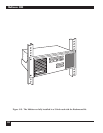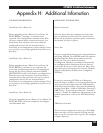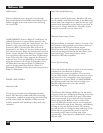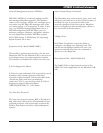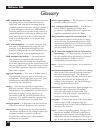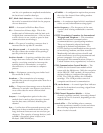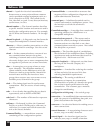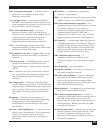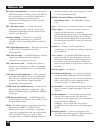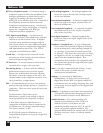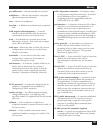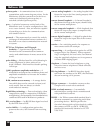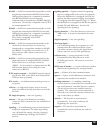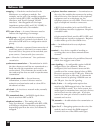
Multiserver 5000
256
DIT, direct in termination — A service offered by a
PBX which allows incoming calls to the PBX to
be routed directly to a selected telephone or
group of telephones without operator
intervention. Billing does not start until the
telephone answers.
DLC, data link control — A communications
protocol that sets up, controls, checks, and
terminates information transfer between two
stations on a data link.
downline loading — The process of sending
configuration parameters, or operating
software, from a controlling device to another
device.
DSP, digital signal processor — This microprocessor
is used in voice compression and fax
demodulation.
DSR, data set ready — An RS-232 interface control
signal that indicates that the modem is
connected to a telephone circuit.
DSU, data service unit — A DCE that replaces a
modem in connection to a DDS: a baseband
device, often included in the cost of the DDS
circuits.
DTE, data terminal equipment — The equipment
serving as the data source and/or destination.
May refer to computer ports, terminals, and
printers. Also, interface signals typically
presented by this equipment.
DTMF, Dual Tone Multifrequency — used for call
addressing in pushbutton telephones. Also
known as Multifrequency Pushbutton (MFPB)
in Europe.
DTR, data terminal ready — An RS-232 interface
control signal that indicates that a DTE is ready
for data transmission.
E&M — In industry usage, a signaling convention
between voice PBXs. As related to the
Multiserver’s voice/fax module, a strapping
option for compatibility with the tie-trunk side
of a voice PBX. There are 5 types (Type I
through Type V) of E&M strapping options in
domestic models, and 3 types (Types I, II, and
V) in international models.
EBCDIC, Extended Binary Coded Decimal
Interchange Code — An 8-bit IBM character
code.
echo — The return of transmitted data to its origin.
ENQ, enquiry — A control character used as a
request for identification or status in
communications protocols. For example, in the
Hewlett-Packard ENQ/ACK protocol, ENQ is
sent by the transmitting device to determine if
the destination terminal is ready for more data.
See also ACK.
equalizer — A device used by modems to
compensate for distortions caused by telephone
line conditions.
<esc>, escape — An ASCII or EBCDIC character
used to modify the meaning of the character
that follows (dependent on defined protocol).
It is often used to set equipment in different
modes of operation or to position a cursor on a
terminal.
fast busy signal — See Reorder.
Fast Packet multiplexing — A remote networking
technique that dynamically combines various
signals including voice, fax, async and sync data,
video, and LAN onto one communications
channel with 95% or better efficiency.
fax, facsimile — Transmission of hardcopy (written,
typed, or drawn) images through a voice/fax
channel.
Fax Demodulation — A technique for detecting a
Group 3 fax signal on the voice line and
reducing it to its original speed for transmission
across the link (64 Kbps to
9.6 Kbps). At the other side, the signal is
recognized as fax and is sent to the appropriate
device.
fax sharing device — A device used when a fax
machine is shared between the Public Switched
Telephone Network (PSTN) and the



